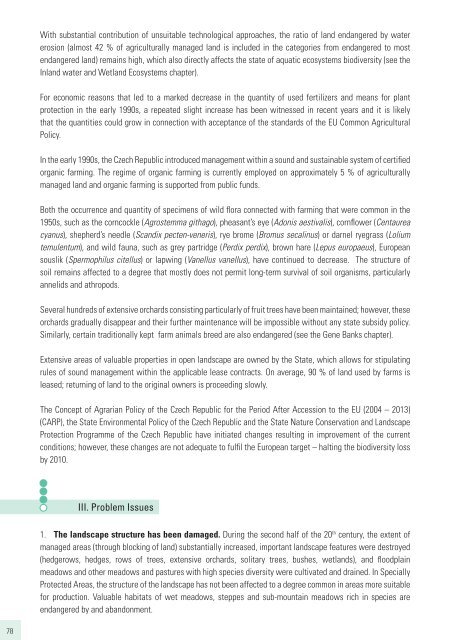B - Convention on Biological Diversity
B - Convention on Biological Diversity
B - Convention on Biological Diversity
- No tags were found...
You also want an ePaper? Increase the reach of your titles
YUMPU automatically turns print PDFs into web optimized ePapers that Google loves.
With substantial c<strong>on</strong>tributi<strong>on</strong> of unsuitable technological approaches, the ratio of land endangered by watererosi<strong>on</strong> (almost 42 % of agriculturally managed land is included in the categories from endangered to mostendangered land) remains high, which also directly affects the state of aquatic ecosystems biodiversity (see theInland water and Wetland Ecosystems chapter).For ec<strong>on</strong>omic reas<strong>on</strong>s that led to a marked decrease in the quantity of used fertilizers and means for plantprotecti<strong>on</strong> in the early 1990s, a repeated slight increase has been witnessed in recent years and it is likelythat the quantities could grow in c<strong>on</strong>necti<strong>on</strong> with acceptance of the standards of the EU Comm<strong>on</strong> AgriculturalPolicy.In the early 1990s, the Czech Republic introduced management within a sound and sustainable system of certifiedorganic farming. The regime of organic farming is currently employed <strong>on</strong> approximately 5 % of agriculturallymanaged land and organic farming is supported from public funds.Both the occurrence and quantity of specimens of wild flora c<strong>on</strong>nected with farming that were comm<strong>on</strong> in the1950s, such as the corncockle (Agrostemma githago), pheasant’s eye (Ad<strong>on</strong>is aestivalis), cornflower (Centaureacyanus), shepherd’s needle (Scandix pecten-veneris), rye brome (Bromus secalinus) or darnel ryegrass (Loliumtemulentum), and wild fauna, such as grey partridge (Perdix perdix), brown hare (Lepus europaeus), Europeansouslik (Spermophilus citellus) or lapwing (Vanellus vanellus), have c<strong>on</strong>tinued to decrease. The structure ofsoil remains affected to a degree that mostly does not permit l<strong>on</strong>g-term survival of soil organisms, particularlyannelids and athropods.Several hundreds of extensive orchards c<strong>on</strong>sisting particularly of fruit trees have been maintained; however, theseorchards gradually disappear and their further maintenance will be impossible without any state subsidy policy.Similarly, certain traditi<strong>on</strong>ally kept farm animals breed are also endangered (see the Gene Banks chapter).Extensive areas of valuable properties in open landscape are owned by the State, which allows for stipulatingrules of sound management within the applicable lease c<strong>on</strong>tracts. On average, 90 % of land used by farms isleased; returning of land to the original owners is proceeding slowly.The C<strong>on</strong>cept of Agrarian Policy of the Czech Republic for the Period After Accessi<strong>on</strong> to the EU (2004 – 2013)(CARP), the State Envir<strong>on</strong>mental Policy of the Czech Republic and the State Nature C<strong>on</strong>servati<strong>on</strong> and LandscapeProtecti<strong>on</strong> Programme of the Czech Republic have initiated changes resulting in improvement of the currentc<strong>on</strong>diti<strong>on</strong>s; however, these changes are not adequate to fulfil the European target – halting the biodiversity lossby 2010.III. Problem Issues1. The landscape structure has been damaged. During the sec<strong>on</strong>d half of the 20 th century, the extent ofmanaged areas (through blocking of land) substantially increased, important landscape features were destroyed(hedgerows, hedges, rows of trees, extensive orchards, solitary trees, bushes, wetlands), and floodplainmeadows and other meadows and pastures with high species diversity were cultivated and drained. In SpeciallyProtected Areas, the structure of the landscape has not been affected to a degree comm<strong>on</strong> in areas more suitablefor producti<strong>on</strong>. Valuable habitats of wet meadows, steppes and sub-mountain meadows rich in species areendangered by and aband<strong>on</strong>ment.78
















